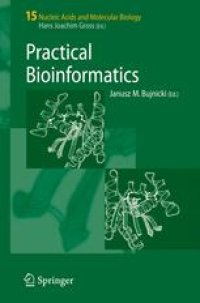
Ebook: Practical Bioinformatics
- Tags: Bioinformatics, Biochemical Engineering, Genetic Engineering, Biochemistry general, Computer Appl. in Life Sciences
- Series: Nucleic Acids and Molecular Biology 15
- Year: 2008
- Publisher: Springer-Verlag Berlin Heidelberg
- Edition: 1
- Language: English
- pdf
The book is unique in that it bridges the gap between bioinformaticists and molecular biologists, i.e. the developers and the users of computational methods for biological data analysis and in that it presents examples of practical applications of the bioinformatics tools in the "daily practice" of an experimental research scientist.
The book starts with reviews on computational methods for protein sequence-structure-function analysis (sequence studies, structure prediction), followed by methods that explicitly utilize experimental data routinely obtained in the laboratory to improve the functional predictions. The second part comprises a series of examples on how particular applications of different types of bioinformatics methods in combination with experimental studies to validate the hypotheses have led to important scientific discoveries.
Therefore, the book is a guide to application of bioinformatics methods in molecular biology, addressed mainly to research scientists, postdocs, and advanced graduate students.
The book is unique in that it bridges the gap between bioinformaticists and molecular biologists, i.e. the developers and the users of computational methods for biological data analysis and in that it presents examples of practical applications of the bioinformatics tools in the "daily practice" of an experimental research scientist.
The book starts with reviews on computational methods for protein sequence-structure-function analysis (sequence studies, structure prediction), followed by methods that explicitly utilize experimental data routinely obtained in the laboratory to improve the functional predictions. The second part comprises a series of examples on how particular applications of different types of bioinformatics methods in combination with experimental studies to validate the hypotheses have led to important scientific discoveries.
Therefore, the book is a guide to application of bioinformatics methods in molecular biology, addressed mainly to research scientists, postdocs, and advanced graduate students.
The book is unique in that it bridges the gap between bioinformaticists and molecular biologists, i.e. the developers and the users of computational methods for biological data analysis and in that it presents examples of practical applications of the bioinformatics tools in the "daily practice" of an experimental research scientist.
The book starts with reviews on computational methods for protein sequence-structure-function analysis (sequence studies, structure prediction), followed by methods that explicitly utilize experimental data routinely obtained in the laboratory to improve the functional predictions. The second part comprises a series of examples on how particular applications of different types of bioinformatics methods in combination with experimental studies to validate the hypotheses have led to important scientific discoveries.
Therefore, the book is a guide to application of bioinformatics methods in molecular biology, addressed mainly to research scientists, postdocs, and advanced graduate students.
Content:
Front Matter....Pages I-XVII
Computational Methods for Protein Structure Prediction and Fold Recognition....Pages 1-21
‘Meta’Approaches to Protein Structure Prediction....Pages 23-34
From Molecular Modeling to Drug Design....Pages 35-71
Structure Determination of Macromolecular Complexes by Experiment and Computation....Pages 73-96
Modeling Protein Folding Pathways....Pages 97-122
Structural Bioinformatics and NMR Structure Determination....Pages 123-137
Bioinformatics-Guided Identification and Experimental Characterization of Novel RNA Methyltransferas....Pages 139-168
Finding Missing tRNA Modification Genes: A Comparative Genomics Goldmine....Pages 169-190
Evolution and Function of Processosome, the Complex That Assembles Ribosomes in Eukaryotes: Clues from Comparative Sequence Analysis....Pages 191-219
Bioinformatics-Guided Experimental Characterization of Mismatch-Repair Enzymes and Their Relatives....Pages 221-241
Predicting Functional Residues in DNA Glycosylases by Analysis of Structure and Conservation....Pages 243-261
Back Matter....Pages 263-265
The book is unique in that it bridges the gap between bioinformaticists and molecular biologists, i.e. the developers and the users of computational methods for biological data analysis and in that it presents examples of practical applications of the bioinformatics tools in the "daily practice" of an experimental research scientist.
The book starts with reviews on computational methods for protein sequence-structure-function analysis (sequence studies, structure prediction), followed by methods that explicitly utilize experimental data routinely obtained in the laboratory to improve the functional predictions. The second part comprises a series of examples on how particular applications of different types of bioinformatics methods in combination with experimental studies to validate the hypotheses have led to important scientific discoveries.
Therefore, the book is a guide to application of bioinformatics methods in molecular biology, addressed mainly to research scientists, postdocs, and advanced graduate students.
Content:
Front Matter....Pages I-XVII
Computational Methods for Protein Structure Prediction and Fold Recognition....Pages 1-21
‘Meta’Approaches to Protein Structure Prediction....Pages 23-34
From Molecular Modeling to Drug Design....Pages 35-71
Structure Determination of Macromolecular Complexes by Experiment and Computation....Pages 73-96
Modeling Protein Folding Pathways....Pages 97-122
Structural Bioinformatics and NMR Structure Determination....Pages 123-137
Bioinformatics-Guided Identification and Experimental Characterization of Novel RNA Methyltransferas....Pages 139-168
Finding Missing tRNA Modification Genes: A Comparative Genomics Goldmine....Pages 169-190
Evolution and Function of Processosome, the Complex That Assembles Ribosomes in Eukaryotes: Clues from Comparative Sequence Analysis....Pages 191-219
Bioinformatics-Guided Experimental Characterization of Mismatch-Repair Enzymes and Their Relatives....Pages 221-241
Predicting Functional Residues in DNA Glycosylases by Analysis of Structure and Conservation....Pages 243-261
Back Matter....Pages 263-265
....